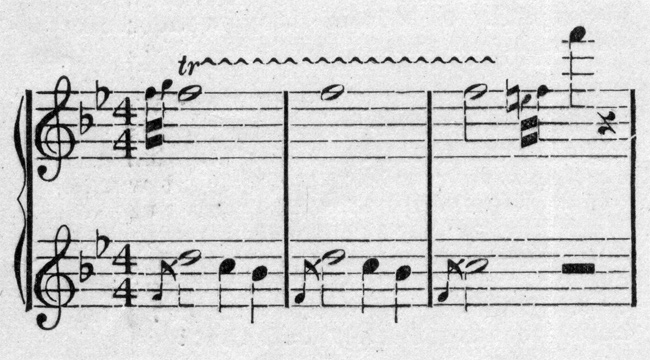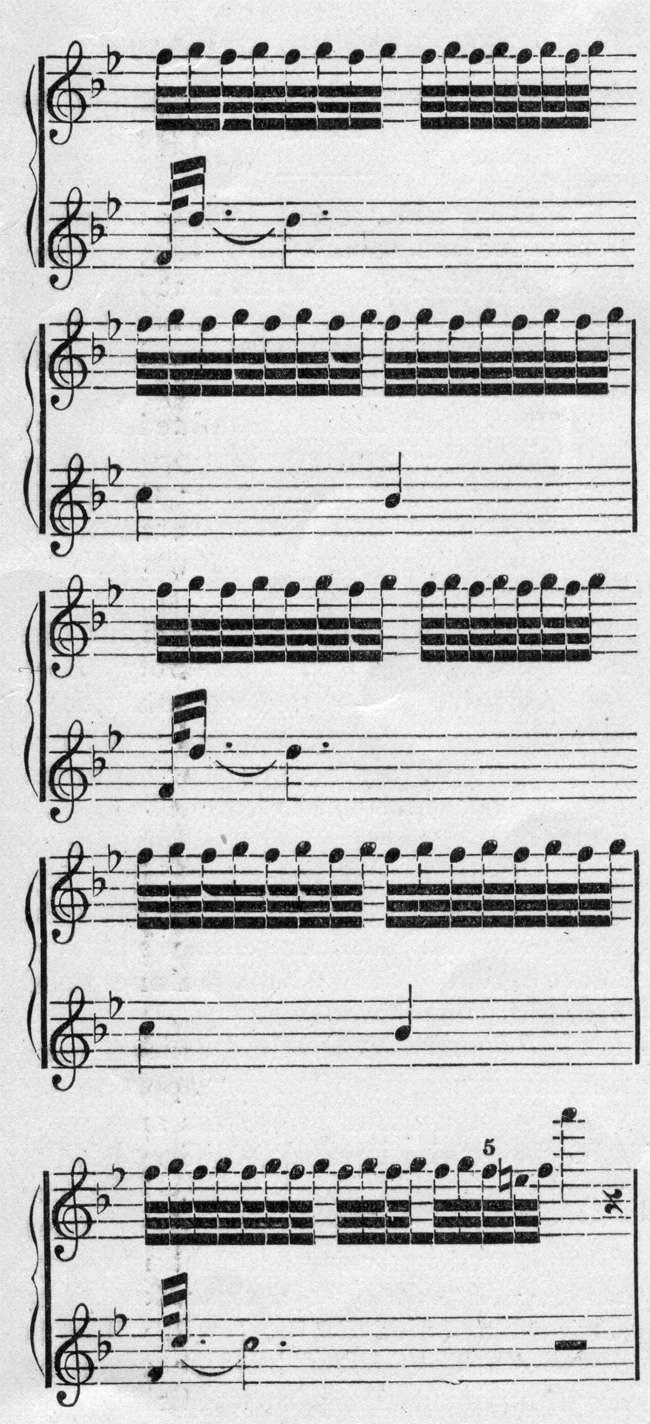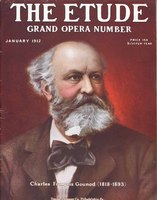Edited by Louis C. Elson
Q. The following passage confuses me greatly. Will you please write out this trill indicating just what notes go together. I think that I would understand it if it were not for the acciaccatura or grace note in the left hand part.

A. The above would be the best way of performance. The two grace notes at the beginning of the trill are unecessary (sic). In notating the above one is tempted to write the chief melody note, after the acciaccatura, as a triple dotted one, but the use of the tie is a simpler notation. It is possible that the two grace notes before the trill are only there to show that the trill is expected to begin upon the principal note. The passage is more awkward to notate than to perform.

Q. Has America developed any special style of Church music peculiar to itself, apart from gospel hymns? (B. E.)
A. None that is in use to-day, but in the early part of the nineteenth century the almost self-taught native composers did bring forth something that was peculiar to America. This being the land of Liberty, they defied many of the rules of harmony. They would often begin with a little primitive imitation between two parts, and hymns thus constructed they would call “Fugue Tunes,” although they were no more fugues than they were oratorios. You can find some account of this style of music in Elson’s “History of American Music,” and some mention of it in Elson’s “Our National Music and its Sources,” but it was only a passing phase of American sacred music.
Q. Does using the typewriter unfit one for playing upon the piano or any other instrument? (J. K. B.)
A. It does not appear that using the typewriter should unfit anyone for instrumental work, unless he wears out his fingers. The true typewriter touch should give a good staccato and insure strong fingers, hands, wrists and arms. Perhaps the work would be coarse for a violin student, but even then strength could be trained into delicacy. If the typewriter is a source of income, it certainly would not unfit one financially for music study. The piano student who has been addicted to the typewriter can feel assured of the proper muscular development, and should therefore have sufficient control to attain the finer gradations of expressive shading. I may add that I myself use a typewriter constantly and I have not found it in any degree detrimental to piano or organ playing. Per contra, I have found that piano-playing helps one to get a rapid action upon the typewriter.
Q. What is the difference between a suite and a partita? (R. S.)
A. The partita is merely another name for the early suite, or set of dance tunes. The term partita was not usually applied after the dance suite reached its full form in the days of Bach and Handel. In Bach’s hands the suite became fairly definite in form. It had a prelude, if desired, then allemande, courante, sarabande, intermezzi and gigue. The intermezzi were from two to four dances or other movements chosen by the composer, such as minuet, gavotte, air, burlesca, bourée, etc. The succession of movements was not unlike that in the symphony, which was based in part on the suite. The allemande was of a lively character, not unlike an allegro. The courante was a quick dance, not much different from a modern scherzo in effect. The stately sarabande formed the slow movement, while the gigue made a rapid and brilliant finale. In the last century the suite became more modern in character, and grew into an orchestral piece of symphonic character, though freer in style. Lachner used this form well, including effective movements in march and fugue form. Goldmark’s “Rustic Wedding Symphony” is practically a suite. Rimsky-Korsakoff’s “Scheherezade” is an excellent example of symphonic style in a suite, carried through four large movements.
Q. Is the leit-motif as found in the Wagner Operas to be found in the works of other composers previous to Wagner? (T. H. U.)
A. Yes, but by no means with the logic and continuity of the Wagnerian manner. Mozart, in “Don Giovanni,” uses one “leitmotif,” once. In the second act of this opera, Don Giovanni comes to the grave of the Commendatore, whom he has murdered, and in a spirit of bravado, invites the statue standing there to take supper with him that evening. The statue nods its head and sings an awful warning to the reckless Don. In the last act, at the banquet, when all is mirth and jollity, suddenly the warning motive of the statue is heard. This tells its own story, for the Commendatore, or rather his ghost, comes to the table and seizes upon Don Giovanni.
In “Elijah” there is a chorus picturing the famine upon the land—“The Harvest now is over, the Summer Days are Gone.” In the last part of Mendelssohn’s oratorio Elijah speaks of his soul longing for the Lord like a thirsty land, whereupon there comes in the orchestra the beautiful theme of the above chorus. This is certainly a “leitmotif” used very graphically. But Wagner made his Leitmotiven numerous and almost continuous. By means of them the orchestra is constantly speaking a language which is as definite as French or Greek. And Wagner had the power of making his Leitmotiven very condensed and graphic. I doubt if there exist in music three chords more expressive than those which constitute the “Fate-motive” in “Die Walküre,” and other operas of the Trilogy. Study the Sword- motive, the Fire-motive, the Hunding-motive, the Tristan and Isolde motive; if you wish to realize the condensing power of this genius.



